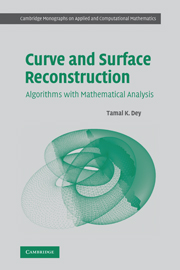6 - Watertight Reconstructions
Published online by Cambridge University Press: 20 August 2009
Summary
Most of the surface reconstruction algorithms face a difficulty when dealing with undersampled surfaces and noise. While the algorithm described in Chapter 5 can detect undersampling, it leaves holes in the surface near the undersampled regions. Although this may be desirable for reconstructing surfaces with boundaries, many applications such as CAD designs require that the output surface be watertight, that is, a surface that bounds a solid. Ideally, this means that the watertight surface should be a compact 2-manifold without any boundary. The two algorithms that are described in this chapter produce these types of surfaces when the input sample is sufficiently dense. However, the algorithms are designed keeping in mind that the sample may not be sufficiently dense everywhere. So, in practice, the algorithms may not produce a perfect manifold surface but their output is watertight in the following sense:
Watertight surface: A 2-complex embedded in ℝ3 whose underlying space is a boundary of the closure of a 3-manifold in ℝ3.
Notice that the above definition allows the watertight surface to be nonmanifold. The closure of a 3-manifold can indeed introduce nonmanifold property; for example, a surface pinched at a point can be in the closure of a 3-manifold.
Power Crust
In Chapter 4, we have seen that the poles for a dense point sample lie quite far away from all samples (proof of the Pole Lemma 4.1) and hence from the surface. Indeed, they lie close to the medial axis.
- Type
- Chapter
- Information
- Curve and Surface ReconstructionAlgorithms with Mathematical Analysis, pp. 93 - 112Publisher: Cambridge University PressPrint publication year: 2006



